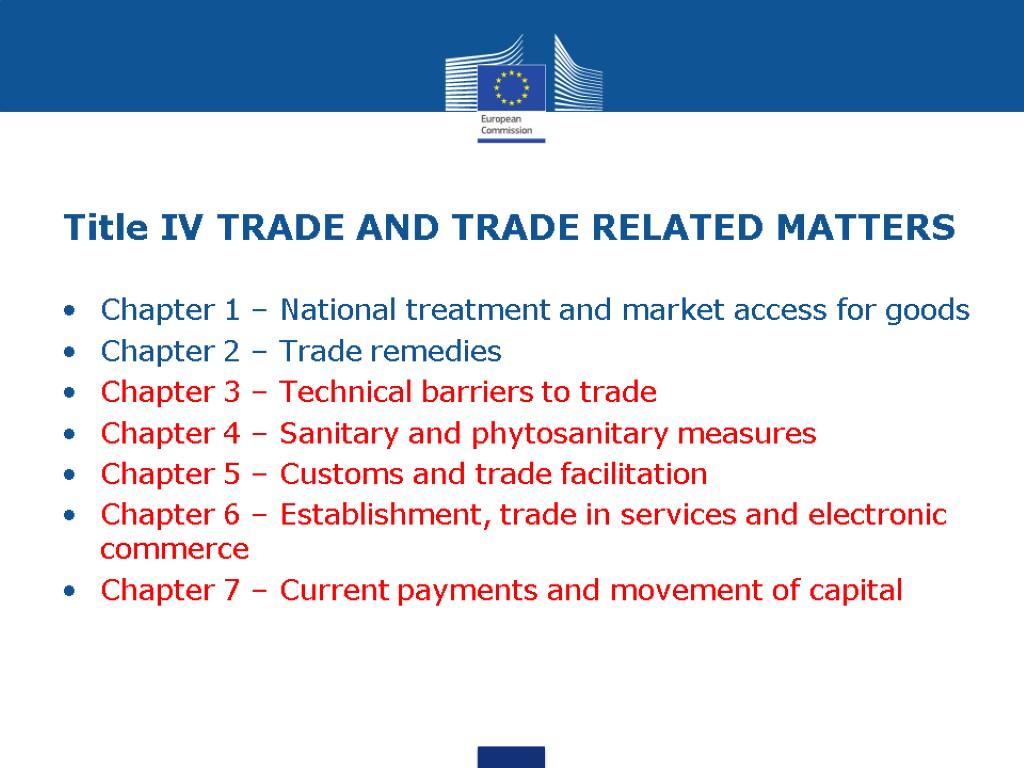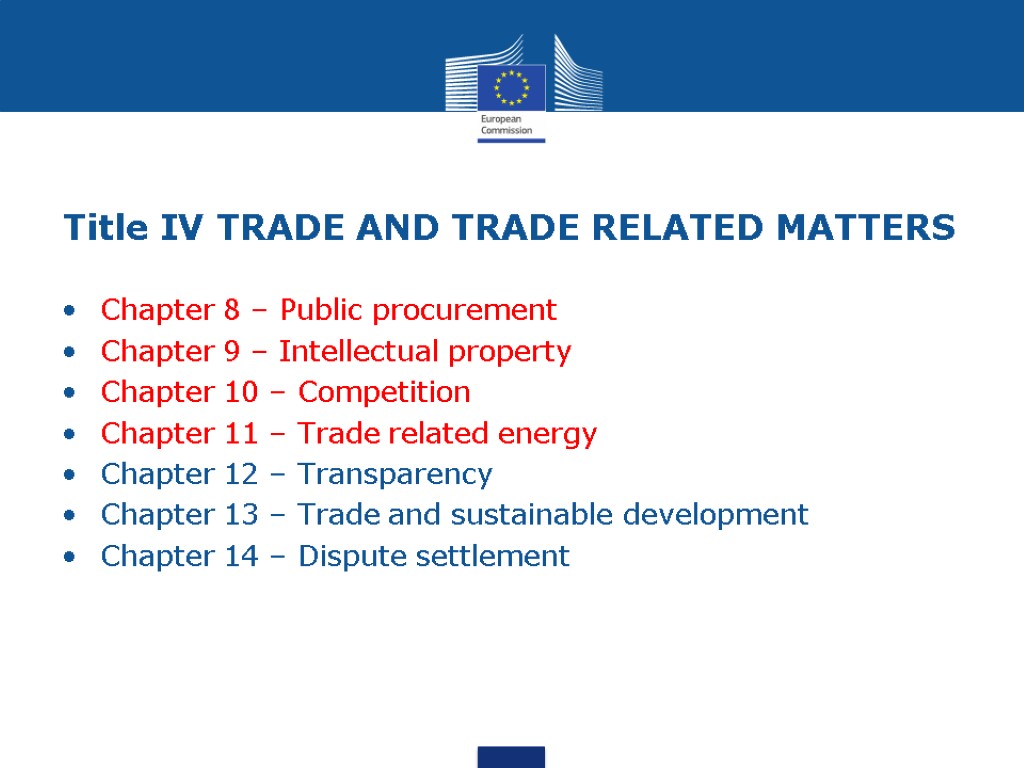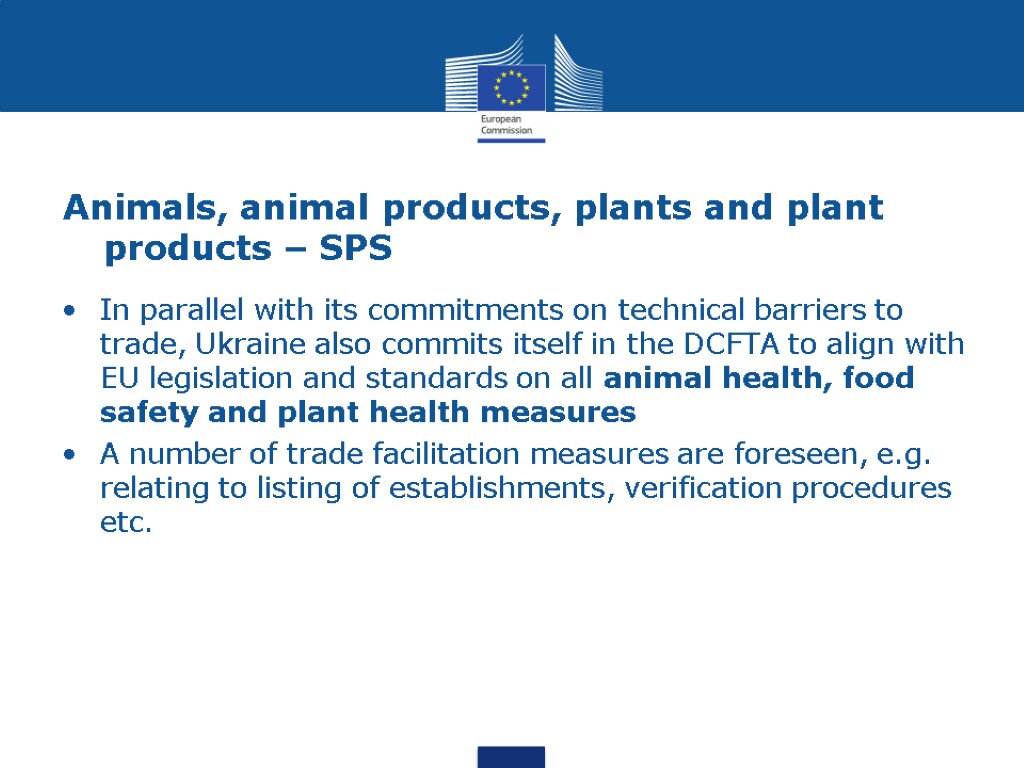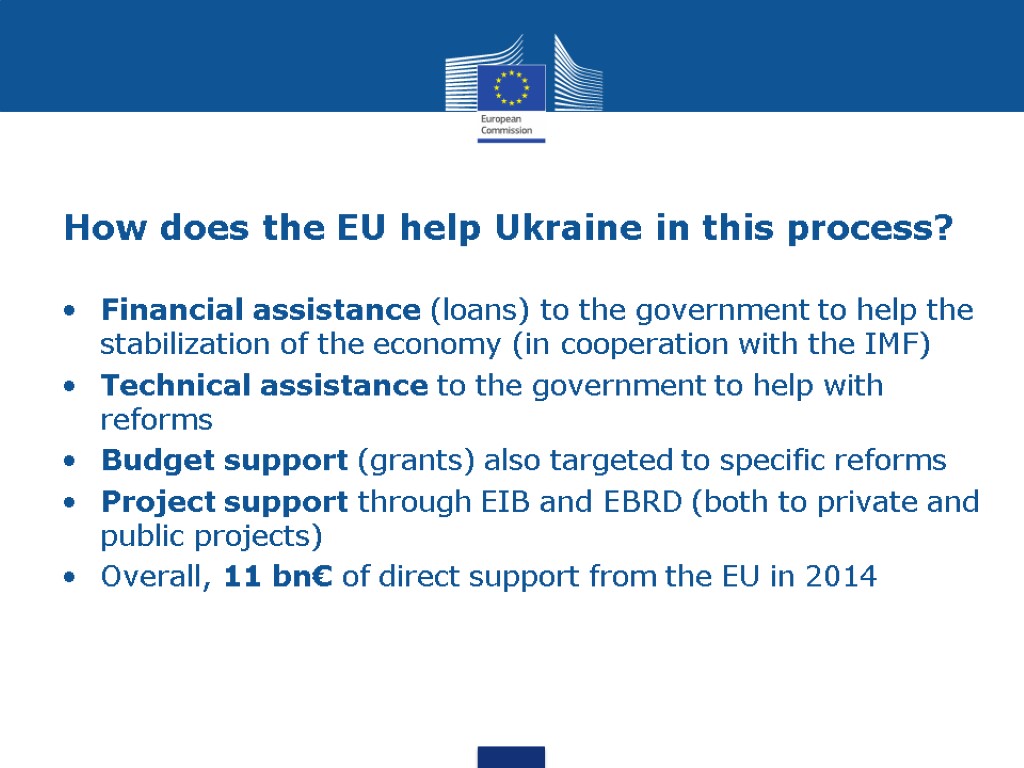EU and UKRAINE Existing and future economic relations.


















ukraine_presentation_october_2014.ppt
- Количество слайдов: 17
 EU and UKRAINE Existing and future economic relations
EU and UKRAINE Existing and future economic relations
 Ukraine and the EU: trade relations (2013) Ukraine's total exports to the rest of the world: €48,5 bn Ukraine's total imports from the rest of the world: €59,0 bn Trade balance: -€10,5 bn (7,9% of GDP) Exports to EU: €12,9 bn (26,5% of exports) Imports from EU: €20,7 bn (35,1% of imports) Trade balance with the EU: -€8,6 bn Exports to Russia: €11,6bn (23,8% of exports) Imports from Russia: €17,8bn (30.2% of imports) Trade balance with Russia: -€6,2bn
Ukraine and the EU: trade relations (2013) Ukraine's total exports to the rest of the world: €48,5 bn Ukraine's total imports from the rest of the world: €59,0 bn Trade balance: -€10,5 bn (7,9% of GDP) Exports to EU: €12,9 bn (26,5% of exports) Imports from EU: €20,7 bn (35,1% of imports) Trade balance with the EU: -€8,6 bn Exports to Russia: €11,6bn (23,8% of exports) Imports from Russia: €17,8bn (30.2% of imports) Trade balance with Russia: -€6,2bn
 Association Agreement and Deep and Comprehensive Free Trade Area – basic facts The Association Agreement between the EU and Ukraine is a complex instrument ! Two elements: a) political / justice / cooperation and b) trade and economic integration, the so-called DCFTA (title 4) The DCFTA includes a classic FTA part (tariffs) but also an extensive section on alignment of regulations between EU and Ukraine (non-tariff barriers) AA/DCFTA was signed on 27 June, ratified by Ukraine on 15 September and now the ratification process (by the Parliaments of Member states) is ongoing on the EU side AA/DCFTA will enter into force provisionally on 1st November 2014, with the exception of the DCFTA (end 2015)
Association Agreement and Deep and Comprehensive Free Trade Area – basic facts The Association Agreement between the EU and Ukraine is a complex instrument ! Two elements: a) political / justice / cooperation and b) trade and economic integration, the so-called DCFTA (title 4) The DCFTA includes a classic FTA part (tariffs) but also an extensive section on alignment of regulations between EU and Ukraine (non-tariff barriers) AA/DCFTA was signed on 27 June, ratified by Ukraine on 15 September and now the ratification process (by the Parliaments of Member states) is ongoing on the EU side AA/DCFTA will enter into force provisionally on 1st November 2014, with the exception of the DCFTA (end 2015)
 What is the DCFTA ? Objectives : To facilitate and increase trade between the EU and Ukraine To stimulate economic growth, new jobs To integrate better the EU and Ukrainian economies To improve the business and investment climate in Ukraine How? by tackling tariff and non-tariff barriers Tariff barriers (the FTA part): Most import tariffs and duties will be removed or reduced Non-tariff barriers (the "DC" part): Ukrainian legislation, norms, standards and practices will be aligned with EU rules
What is the DCFTA ? Objectives : To facilitate and increase trade between the EU and Ukraine To stimulate economic growth, new jobs To integrate better the EU and Ukrainian economies To improve the business and investment climate in Ukraine How? by tackling tariff and non-tariff barriers Tariff barriers (the FTA part): Most import tariffs and duties will be removed or reduced Non-tariff barriers (the "DC" part): Ukrainian legislation, norms, standards and practices will be aligned with EU rules
 "FTA part" of the DCFTA FTA is a core element of any bilateral trade agreement Liberalises most tariffs both ways, in line with the provision of the WTO / GATT (elimination of "substantially all the trade") Phase-in periods for many products – up to 7 years EU-UA FTA is asymmetrical: Ukraine has more time to adapt Tariff rate quotas (TRQs) for certain agricultural products (NOT absolute import quotas) Details specified in the AA/DCFTA (in two annexes, one for Ukraine, one for the EU)
"FTA part" of the DCFTA FTA is a core element of any bilateral trade agreement Liberalises most tariffs both ways, in line with the provision of the WTO / GATT (elimination of "substantially all the trade") Phase-in periods for many products – up to 7 years EU-UA FTA is asymmetrical: Ukraine has more time to adapt Tariff rate quotas (TRQs) for certain agricultural products (NOT absolute import quotas) Details specified in the AA/DCFTA (in two annexes, one for Ukraine, one for the EU)
 Autonomous trade measures (ATMs) In normal circumstances, the FTA annexes (tariff reductions and increase of TRQs) would come into force on first day of entry into force of AA/DCFTA But, due to economic, security and political challenges faced by Ukraine, and EU desire to assist and support Ukraine's economic reform and integration with EU, ATMs were introduced in April 2014 Unilateral action by EU: no reciprocal action expected by Ukraine EU has anticipated year one of the tariff schedules in DCFTA – ie. EU has begun elimination and reduction of tariffs and opening of TRQs foreseen in DCFTA
Autonomous trade measures (ATMs) In normal circumstances, the FTA annexes (tariff reductions and increase of TRQs) would come into force on first day of entry into force of AA/DCFTA But, due to economic, security and political challenges faced by Ukraine, and EU desire to assist and support Ukraine's economic reform and integration with EU, ATMs were introduced in April 2014 Unilateral action by EU: no reciprocal action expected by Ukraine EU has anticipated year one of the tariff schedules in DCFTA – ie. EU has begun elimination and reduction of tariffs and opening of TRQs foreseen in DCFTA
 Examples of non-tariff barriers Licenses Standards Red tape (at the border and beyond) Monetary restrictions Geographical indications (GIs) Public procurement rules State subsidies which distort competition Investment protection rules Many other instruments (e.g. car recycling fee in Russian Federation)
Examples of non-tariff barriers Licenses Standards Red tape (at the border and beyond) Monetary restrictions Geographical indications (GIs) Public procurement rules State subsidies which distort competition Investment protection rules Many other instruments (e.g. car recycling fee in Russian Federation)
 Are non tariff barriers legal / legitimate? Are they legal (i.e. in line with WTO rules) = do they discriminate between imported and national goods? Very often they are legal: all companies have to comply with the same standards (e.g. driving side of the street) Sometimes they are used as a de facto discrimination tools (e.g. tax rebates on specific products only produced nationally) Are they legitimate? Very often they just represent a burden for businesses, and therefore are unjustified from an economic point of view (same economic theories as for tariff barriers) However, national preferences vary from one country to another (GMOs, hormones, pasteurized cheese, wine techniques, etc)
Are non tariff barriers legal / legitimate? Are they legal (i.e. in line with WTO rules) = do they discriminate between imported and national goods? Very often they are legal: all companies have to comply with the same standards (e.g. driving side of the street) Sometimes they are used as a de facto discrimination tools (e.g. tax rebates on specific products only produced nationally) Are they legitimate? Very often they just represent a burden for businesses, and therefore are unjustified from an economic point of view (same economic theories as for tariff barriers) However, national preferences vary from one country to another (GMOs, hormones, pasteurized cheese, wine techniques, etc)
 Association agreement (486 articles) PREAMBLE Title I GENERAL PRINCIPLES Title II POLITICAL DIALOGUE AND REFORM, POLITICAL ASSOCIATION, COOPERATION IN THE FIELD OF FOREIGN AND SECURITY POLICY Title III JUSTICE AND FREEDOM Title IV TRADE AND TRADE RELATED MATTERS (art 25-336) Title V ECONOMIC AND SECTOR COOPERATION Title VI FINANCIAL COOPERATION Title VII INSTITUTIONNAL, GENERAL AND FINAL PROVISIONS …and lots of annexes!
Association agreement (486 articles) PREAMBLE Title I GENERAL PRINCIPLES Title II POLITICAL DIALOGUE AND REFORM, POLITICAL ASSOCIATION, COOPERATION IN THE FIELD OF FOREIGN AND SECURITY POLICY Title III JUSTICE AND FREEDOM Title IV TRADE AND TRADE RELATED MATTERS (art 25-336) Title V ECONOMIC AND SECTOR COOPERATION Title VI FINANCIAL COOPERATION Title VII INSTITUTIONNAL, GENERAL AND FINAL PROVISIONS …and lots of annexes!
 Title IV TRADE AND TRADE RELATED MATTERS Chapter 1 – National treatment and market access for goods Chapter 2 – Trade remedies Chapter 3 – Technical barriers to trade Chapter 4 – Sanitary and phytosanitary measures Chapter 5 – Customs and trade facilitation Chapter 6 – Establishment, trade in services and electronic commerce Chapter 7 – Current payments and movement of capital
Title IV TRADE AND TRADE RELATED MATTERS Chapter 1 – National treatment and market access for goods Chapter 2 – Trade remedies Chapter 3 – Technical barriers to trade Chapter 4 – Sanitary and phytosanitary measures Chapter 5 – Customs and trade facilitation Chapter 6 – Establishment, trade in services and electronic commerce Chapter 7 – Current payments and movement of capital
 Title IV TRADE AND TRADE RELATED MATTERS Chapter 8 – Public procurement Chapter 9 – Intellectual property Chapter 10 – Competition Chapter 11 – Trade related energy Chapter 12 – Transparency Chapter 13 – Trade and sustainable development Chapter 14 – Dispute settlement
Title IV TRADE AND TRADE RELATED MATTERS Chapter 8 – Public procurement Chapter 9 – Intellectual property Chapter 10 – Competition Chapter 11 – Trade related energy Chapter 12 – Transparency Chapter 13 – Trade and sustainable development Chapter 14 – Dispute settlement
 Industrial goods - Technical Barriers to Trade (TBTs) The DCFTA foresees widespread alignment between Ukrainian and EU standards, both for industrial goods and agricultural products In 2005-2006, Ukrainian companies wishing to export to the EU faced additional production costs of about 14% on average in order to ensure that their products met EU standards The use of EU standards will not only make Ukrainian products more competitive on the EU market but also in the rest of the world – the growing markets of the Far East, Middle East, Africa and America
Industrial goods - Technical Barriers to Trade (TBTs) The DCFTA foresees widespread alignment between Ukrainian and EU standards, both for industrial goods and agricultural products In 2005-2006, Ukrainian companies wishing to export to the EU faced additional production costs of about 14% on average in order to ensure that their products met EU standards The use of EU standards will not only make Ukrainian products more competitive on the EU market but also in the rest of the world – the growing markets of the Far East, Middle East, Africa and America
 Animals, animal products, plants and plant products – SPS In parallel with its commitments on technical barriers to trade, Ukraine also commits itself in the DCFTA to align with EU legislation and standards on all animal health, food safety and plant health measures A number of trade facilitation measures are foreseen, e.g. relating to listing of establishments, verification procedures etc.
Animals, animal products, plants and plant products – SPS In parallel with its commitments on technical barriers to trade, Ukraine also commits itself in the DCFTA to align with EU legislation and standards on all animal health, food safety and plant health measures A number of trade facilitation measures are foreseen, e.g. relating to listing of establishments, verification procedures etc.
 Services In the field of services, the DCFTA is unprecedented in the extent of its liberalisation The services chapter is based on the services part of the association agreements that were concluded with countries acceding to the EU – for example with Croatia It provides for a complete freedom of establishment in all services and non-services sectors (with a limited number of reservations). Furthermore, the DCFTA foresees gradual legislative alignment in financial services, telecom services, postal and courier services, and maritime services
Services In the field of services, the DCFTA is unprecedented in the extent of its liberalisation The services chapter is based on the services part of the association agreements that were concluded with countries acceding to the EU – for example with Croatia It provides for a complete freedom of establishment in all services and non-services sectors (with a limited number of reservations). Furthermore, the DCFTA foresees gradual legislative alignment in financial services, telecom services, postal and courier services, and maritime services
 Other fields (1/2) Provisions on freer capital movement will help to enhance economic growth by allowing easier access to capital and better allocation of capital to its most productive use There will be gradual alignment of UA's legislation on public procurement with that of the EU. With the sole exception of the defence sector, this would allow mutual unrestricted access of EU and UA suppliers and service providers to each others public procurement markets Competition policy is another area which should see major improvements. UA has agreed to progressively align its legislation with that of the EU
Other fields (1/2) Provisions on freer capital movement will help to enhance economic growth by allowing easier access to capital and better allocation of capital to its most productive use There will be gradual alignment of UA's legislation on public procurement with that of the EU. With the sole exception of the defence sector, this would allow mutual unrestricted access of EU and UA suppliers and service providers to each others public procurement markets Competition policy is another area which should see major improvements. UA has agreed to progressively align its legislation with that of the EU
 Other fields (2/2) There are very detailed provisions in the DCFTA regarding intellectual property rights, including a strong section on enforcement of legislation based on EU rules and detailed provisions on so-called geographical indications (GIs) Regarding customs, we already have relatively good cooperation but the DCFTA enhances this by establishing a framework for mutual administrative assistance to ensure the correct application of customs legislation, cooperation on customs irregularities and fraud etc. There are a number of trade related energy provisions which will establish rules on the pricing of energy goods (to let market prices prevail and to prohibit dual pricing)
Other fields (2/2) There are very detailed provisions in the DCFTA regarding intellectual property rights, including a strong section on enforcement of legislation based on EU rules and detailed provisions on so-called geographical indications (GIs) Regarding customs, we already have relatively good cooperation but the DCFTA enhances this by establishing a framework for mutual administrative assistance to ensure the correct application of customs legislation, cooperation on customs irregularities and fraud etc. There are a number of trade related energy provisions which will establish rules on the pricing of energy goods (to let market prices prevail and to prohibit dual pricing)
 How does the EU help Ukraine in this process? Financial assistance (loans) to the government to help the stabilization of the economy (in cooperation with the IMF) Technical assistance to the government to help with reforms Budget support (grants) also targeted to specific reforms Project support through EIB and EBRD (both to private and public projects) Overall, 11 bn€ of direct support from the EU in 2014
How does the EU help Ukraine in this process? Financial assistance (loans) to the government to help the stabilization of the economy (in cooperation with the IMF) Technical assistance to the government to help with reforms Budget support (grants) also targeted to specific reforms Project support through EIB and EBRD (both to private and public projects) Overall, 11 bn€ of direct support from the EU in 2014

